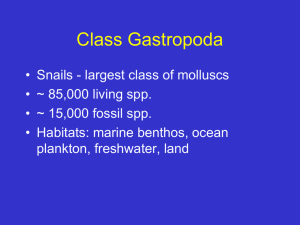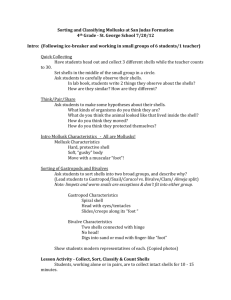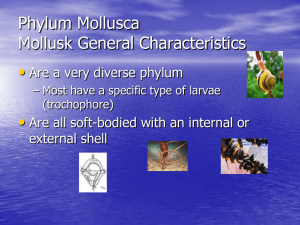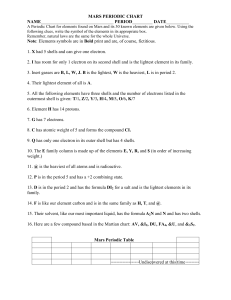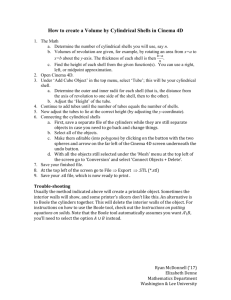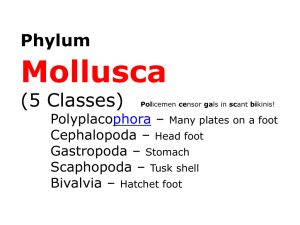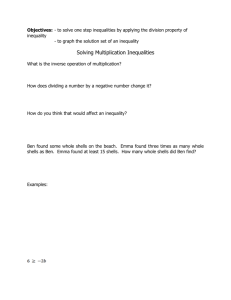Mollusca2
advertisement
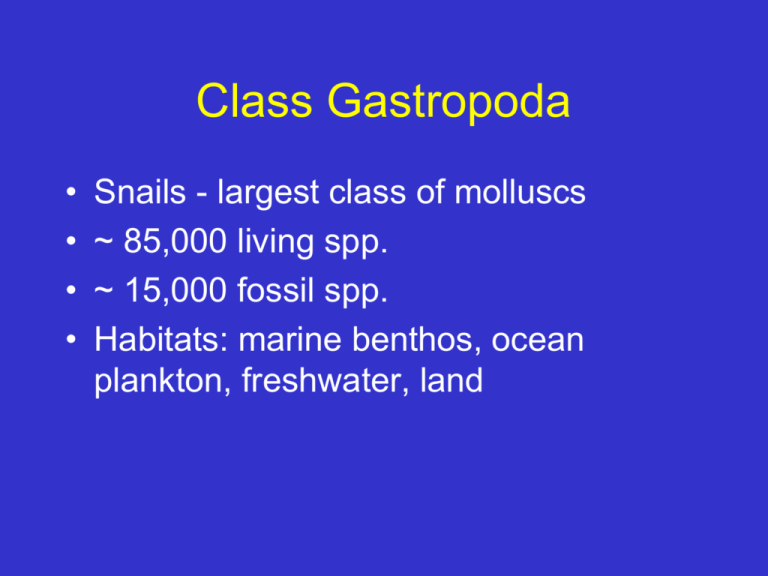
Class Gastropoda • • • • Snails - largest class of molluscs ~ 85,000 living spp. ~ 15,000 fossil spp. Habitats: marine benthos, ocean plankton, freshwater, land Gastropod characteristics • 1. Torsion - primitive bilateral symmetry lost during development • Twisting of visceral mass, mantle, and mantle cavity After torsion Gastropod characteristics • • • • 2. Definite head: eyes, tentacles 3. Flat ventral foot 4. Mantle cavity w/gills or lungs 5. Buccal cavity w/ radula Characters cont. • 6. Coiled shell - one continuous piece – operculum on posterior foot of some plano-spiral helico-spiral Characters, cont. • 7. Centralized complex nervous system • 8. Hermaphroditic or dioecious • 9. Oviparous or ovoviparous 10. Larval form • Archaeogastropoda have trochophore larva • Many marine snails have veliger larva • Freshwater + terrestrial species usually hatch as young snails Gastropod classification • • • • 3 groups: Caenogastropoda: includes gilled snails Opisthobranchs - reduced shell Pulmonata - lungs Caenogastropoda • • • • Mantle cavity anterior 1 or 2 gills shell and operculum usually present most are dioecious Caenogastropoda • A. slit shells - deep water species – Abalones (Haliotis) – 9 spp on our Pacific coast – Commercially harvested Caenogastropoda • B. keyhole limpets - Fissurella – conical shells • C. Limpets - Acmaea Caenogastropoda • D. topshells, turban shells, star shells – Astraea Neritimorpha • E. Nerites (Nerita) intertidal in Caribbean – some freshwater + terrestrial Prosobranchs • • • • • Male with penis Fertilization internal 1 monopectinate gill 1 auricle 1 coeloduct Prosobranchs • A. Freshwater apple snails – Viviparus, Pomacea Prosobranchs • B. Turret shells - worm shells; caecums, ceriths, some freshwater genera, all have high shells Prosobranchs • C. Violet snails - pelagic grazers on man o’war – Vellela, Porpita – Janthina: secretes bubble mass for floatation Prosobranchs • D. Cap shells, slipper shells – Crepidula change sex w/age • see slides of veliger larva Prosobranchs • E. Conchs - Strombus – Feed on algae, turtlegrass – Commercial harvest in Caribbean • F. Cowries; Cypraea - graze on algae, sponges, gorgonians, and tunicates • Mantle covers most of shell when extended • Favorites of shell-collectors • No periostracum • Italians call them “porcellanos” = little pigs – Porcelain got its name Cowries • G. Heteropods - pelagic, swimming snails w/reduced shell • Carinaria (see Fig. 10-30, p. 399) • H. Moon shells - predators on molluscs: – bore into shells – Lunatia – Polinices Moon shells: • Muscular suction disk holds snail on clam shell • Drill through shell with radula: • Wiggle proboscis into flesh • Remove most of flesh from clam • • • • I. Helmet shells, tritons, tuns Predators on molluscs and echinoderms Long proboscis Large shells • J. Periwinkles - intertidal – Littorina • Mostly same characteristics as Mesogastropoda • Radula has only 3 teeth in a transverse row • Most are marine • Most are carnivores • A. Drills - Murex, Urosalpinx • Drill holes in shells of bivalves and barnacles • Oyster drill and others cause economic losses • B. Whelks - Busycon • Tulip shells - Fasciolaria • Predators and carrion feeders • C. Olives, miters, and volutes • Colorful, mostly tropical snails • prey on invertebrates • D. Cones - Conus • Most prey on inverts • Those that prey on fish can be dangerous to humans • Fig 10-42, p. 409 Conus • Long proboscis with harpoon-like radular tooth • venom gland “Glory of the sea” cone shell Opisthobranchia • Detorsion - brings mantle cavity to right side • 1 gill, 1 auricle, 1 coelomoduct • Shell often reduced or absent • Mantle cavity often reduced or absent • Many are secondarily bilateral symmetric • Hermaphroditic Opisthobranchia • A. Bubble shells - Bulla • Predators with thin, reduced shell Opisthobranchia • • • • • B. Sea hares - Aplysia Thin, caplike shell overgrown by mantle Vegetarians (herbivores) Can eject milky fluid from mantle cavity A. californica has largest body of all gastropods Opisthobranchia • • • • C. Sea slugs With or w/o shell Berthelinia is a “bivalve” gastropod Fig. 10-23, p. 392 Opisthobranchia • D. Pteropods or sea butterflies • 2 orders with and w/o (naked) shells • Planktonic with foot modified into winglike flaps for swimming • Often occur in enormous numbers More Pteropods Opisthobranchia • E. Nudibranchs • Often with secondary gills and cerata (hornlike dorsal projections) • Many endemics Opisthobranchia • F. Parasitic Opisthobranchs • 2 orders • One ectoparisitic on bivalves and annelids • One endoparasitic in sea cucumbers Pulmonata • Charactistics like Opisthobranchia, but w/o gill • Mantle cavity converted to lung • Shell usually present • No operculum • Hermaphroditic Pulmonata • A. freshwater snails: – Lymnaea, Physa, Planorbis – Freshwater limpets • Most come to surface for air • Some have developed secondary gills • Descended from terrestrial ancestors Pulmonata • B. Land snails and slugs – Helix – Limax • C. Intertidal slugs w/posterior anus Class Scaphopoda tusk shells • ~ 300 spp. • Sedentary, marine burrowing, in 6 1800 m depth • Shells resemble elephant tusks • Most burrow in sand, few in mud • Feed on microscopic organisms; foraminiferans • Considered offshoot of early bivalve ancestors Scaphopod characteristics • 1. Tusk-like shell open at both ends • 2. Bilateral symmetry (like bivalves) • 3. Rudimentary head – no eyes – Head has threadlike, food gathering tentacles (captacula) Foot Scaphopod characteristics • 4. Radula present • 5. Circulatory system reduced - sinuses – Gills absent • 6. Dioecious, trochophore and veliger larval stages Scaphopod classification • Two families (representative species): • Dentalium - conical shell • Cadulus + Siphonodentalium - globular shell, enlarged foot

